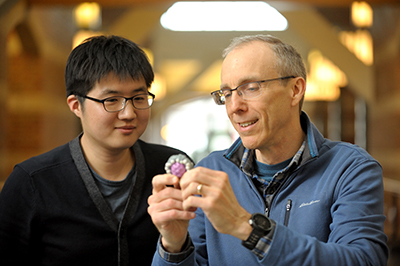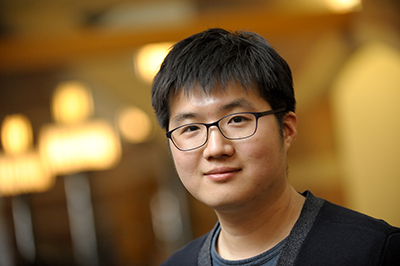Article
He’s not building replicas of a Star Wars airship or of the Taj Mahal, but Semin Lee compares the molecules he builds with to how a child plays with Legos.
“Just as I played with Legos as a kid, I enjoy playing around with molecular building blocks to make new structures on my computer,” Lee said. “This hobby is useful when the molecules have functional applications and becomes even more interesting when they are easy to synthesize.”
New method

A Beckman Postdoctoral Fellow since 2014, Lee works primarily with Jeff Moore, a professor of chemistry and a member of the Autonomous Materials Systems Group. A recent paper, with Lee as first author, outlined a method Lee designed for synthesizing conjugated nanohoops, which are reminiscent of the shortest segment of a carbon nanotube. That paper, “Synthesis of Cycloparaphenyleneacetylene via Alkyne Metathesis: C70 Complexation and Copper-Free Triple Click Reaction,” was published in the Journal of the American Chemical Society (pubs.acs.org/doi/abs/10.1021/jacs.6b08752).
Carbon nanotubes are incredibly useful structures because they are 100 times stronger than steel, but only one-sixth as heavy. Nanotube fibers can be used to strengthen almost any material. They also conduct heat and electricity better than copper, a commonly used conductor.
“If you cut carbon nanotubes, you get rings of cycloparaphenylenes—they are all linearly connected and can bend to form a large hoop,” Lee said. “Despite the recent breakthroughs in preparing these once impossible-to-make compounds, their syntheses are still bottlenecked by the low-yielding ring formation step.”
Lee used dynamic covalent chemistry to overcome this bottleneck. This synthetic technique allows individual building blocks to assemble and disassemble until the stable cyclic structure is reached. Lee plans to apply the nanohoops to organic electronics, such as flexible electronic materials.
Significant advance
“The scientific advance behind Lee’s work is significant,” Moore said. “We are developing shape persistent scaffolding able to place reactive groups precisely in space on nanometer scale distances. The work is relevant to this year’s Nobel Prize in chemistry on molecular machines, but in the future may also be important for precise spatial positioning of biology’s macromolecules.”

One other crucial development is that the three triple bonds within the nanohoop undergo copper-free click reactions three times.
“People avoid copper because it’s toxic,” says Lee. “We’d like to move these into biological studies, so copper-free reactions will enable that.”
Lee believes that his technique for copper-free triple-click reactions, which are very fast and don’t leave any deleterious residue, will enable bioengineers to connect three biomolecules all at once and incorporate nanopores into biological processes at the same time. But there are some obstacles to overcome, primarily creating more stable rings that are compatible with biological media.
“Right now, the compound is very unstable, and the three triple bonds are very reactive,” Lee said. “The only thing that can stabilize it right now is to have C70 inside, but C70 is very expensive.”
“We’re also currently trying to develop other cheaper guest molecules that can stabilize this compound. In addition, larger rings are hypothesized to be more stable but still be able to do this kind of copper-free click reaction.”
A native of Korea, Lee earned his Ph.D. in chemistry from Indiana University and also received the University Graduate School Distinguished Dissertation Award for 2016, the highest honor for research that Indiana University bestows upon its graduate students.
Lee will continue his research as an assistant professor at Louisiana State university starting fall 2017.
Beckman Institute for Advanced Science and Technology